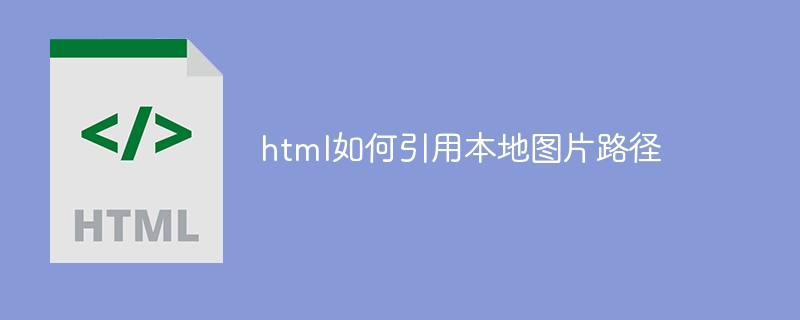How to reference local image path in html
html Methods for referencing local image paths: 1. Use relative paths. If the images and HTML files are in the same folder, you can directly use the file name of the image as the relative path; 2. Use absolute paths. Use absolute paths to reference local images, but this is usually not a best practice because absolute paths may cause problems in different environments; 3. Use Base64 encoding. Base64 encoding is a method of converting images into text strings. Embed image data directly into HTML.

#The operating environment of this article: Windows 10 system, Dell G3 computer.
There are several ways to reference local image paths in HTML, which will be introduced in detail below.
Use relative paths:
A relative path is a path relative to the location of the current HTML file. If the image and HTML file are in the same folder, you can directly use the file name of the image as the relative path. For example, if the image file is named "image.jpg", you can use the following code to reference the image in HTML:
<img src="image.jpg" alt="图片">
If the image file is located in the upper-level folder of the current HTML file, you can use "… /" to represent the upper-level folder. For example, if the image file is located in the "images" folder in the upper-level folder, you can use the following code to reference the image:
<img src="../images/image.jpg" alt="图片">
Similarly, if the image file is located in the lower-level folder of the current HTML file , you can use "./" to represent the current folder. For example, if the picture file is located in the "images" folder of the current folder, you can use the following code to reference the picture:
<img src="./images/image.jpg" alt="图片">
Use the absolute path:
The absolute path is The full path starting from the root directory. It is possible to use absolute paths to reference local images, but this is generally not a best practice as absolute paths can cause problems in different environments. However, if you really need to use an absolute path, you can use the following code to reference the image:
<img src="/path/to/image.jpg" alt="图片">
where "/path/to/" is the path of the image file relative to the root directory.
Use Base64 encoding:
Base64 encoding is a method of converting images into text strings, which can directly embed image data into HTML. This method is suitable for small images or when you need to reduce HTTP requests. You can use the following code to convert the image to Base64 encoding:
<img src="data:image/jpeg;base64,/9j/4AAQSkZJRgABAQEAAAAAAAD/4QA6RXhpZgAATU0AKgAAAAgABwEAAAQAAABsAAAABAAQAAA EBAAABAAAAABsAAAAAAA6ABAAMAAAABAAEAAKACAAQAAAABAAAB9KADAAQAAAABAAAB9AD/2wBDAAoHBwkHBgoJ
Among them, the part after "data:image/jpeg;base64," is the Base64 encoding of the image. Note that this method will increase the size of the HTML file and may affect the page loading speed.
No matter which method you use, you need to ensure that the image file exists in the specified path and that the path is correct. In addition, it is recommended to place the image files in the same folder as the HTML files or in a special image folder for easier management and maintenance.
The above is the detailed content of How to reference local image path in html. For more information, please follow other related articles on the PHP Chinese website!

Hot AI Tools

Undresser.AI Undress
AI-powered app for creating realistic nude photos

AI Clothes Remover
Online AI tool for removing clothes from photos.

Undress AI Tool
Undress images for free

Clothoff.io
AI clothes remover

AI Hentai Generator
Generate AI Hentai for free.

Hot Article

Hot Tools

Notepad++7.3.1
Easy-to-use and free code editor

SublimeText3 Chinese version
Chinese version, very easy to use

Zend Studio 13.0.1
Powerful PHP integrated development environment

Dreamweaver CS6
Visual web development tools

SublimeText3 Mac version
God-level code editing software (SublimeText3)

Hot Topics
 1378
1378
 52
52
 Table Border in HTML
Sep 04, 2024 pm 04:49 PM
Table Border in HTML
Sep 04, 2024 pm 04:49 PM
Guide to Table Border in HTML. Here we discuss multiple ways for defining table-border with examples of the Table Border in HTML.
 HTML margin-left
Sep 04, 2024 pm 04:48 PM
HTML margin-left
Sep 04, 2024 pm 04:48 PM
Guide to HTML margin-left. Here we discuss a brief overview on HTML margin-left and its Examples along with its Code Implementation.
 Nested Table in HTML
Sep 04, 2024 pm 04:49 PM
Nested Table in HTML
Sep 04, 2024 pm 04:49 PM
This is a guide to Nested Table in HTML. Here we discuss how to create a table within the table along with the respective examples.
 HTML Table Layout
Sep 04, 2024 pm 04:54 PM
HTML Table Layout
Sep 04, 2024 pm 04:54 PM
Guide to HTML Table Layout. Here we discuss the Values of HTML Table Layout along with the examples and outputs n detail.
 HTML Input Placeholder
Sep 04, 2024 pm 04:54 PM
HTML Input Placeholder
Sep 04, 2024 pm 04:54 PM
Guide to HTML Input Placeholder. Here we discuss the Examples of HTML Input Placeholder along with the codes and outputs.
 HTML Ordered List
Sep 04, 2024 pm 04:43 PM
HTML Ordered List
Sep 04, 2024 pm 04:43 PM
Guide to the HTML Ordered List. Here we also discuss introduction of HTML Ordered list and types along with their example respectively
 Moving Text in HTML
Sep 04, 2024 pm 04:45 PM
Moving Text in HTML
Sep 04, 2024 pm 04:45 PM
Guide to Moving Text in HTML. Here we discuss an introduction, how marquee tag work with syntax and examples to implement.
 HTML onclick Button
Sep 04, 2024 pm 04:49 PM
HTML onclick Button
Sep 04, 2024 pm 04:49 PM
Guide to HTML onclick Button. Here we discuss their introduction, working, examples and onclick Event in various events respectively.




